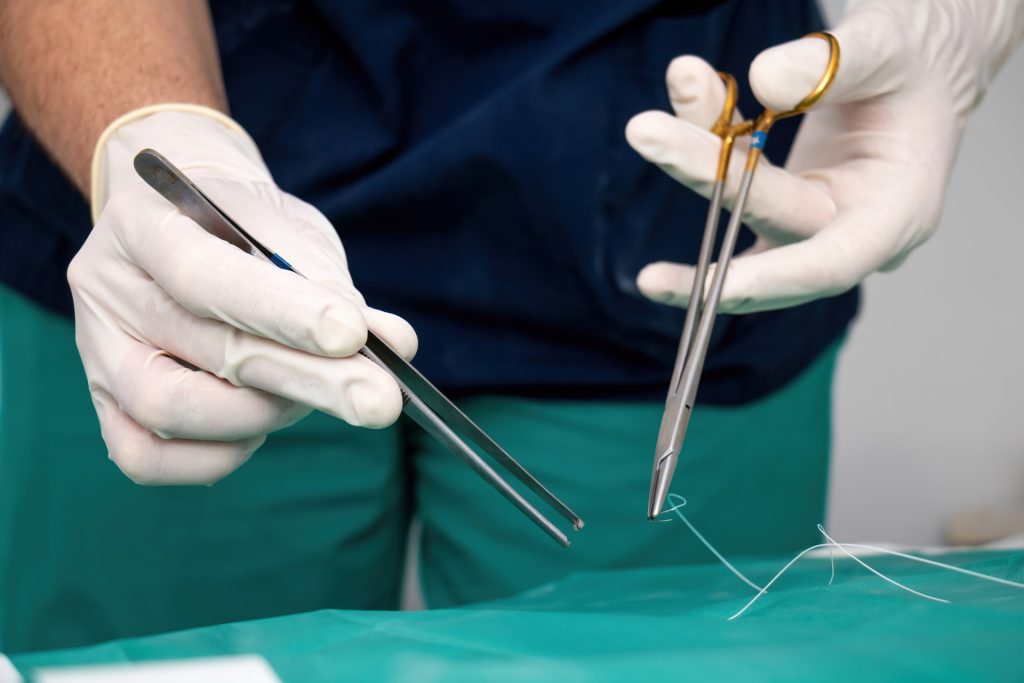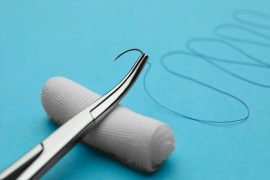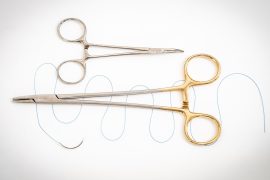What is a cardiac valve?
The cardiac valves are structures in the heart that regulate blood flow through the heart’s chambers and into the major blood vessels. The cardiac valves are crucial for overall cardiovascular health. Problems with the valves can cause various health issues. Treatment options may include medication or surgery.
What is valve replacement surgery?
Valve replacement surgery is when a diseased or damaged heart valve is replaced with a new valve. Several types of valves can be replaced, like the aortic valve, mitral valve, tricuspid valve, and pulmonary valve. The specific procedure used to replace a valve will depend on the location, the type of valve being replaced, and the patient’s overall health.
Importance of Sutures in Valve Replacement Procedure
The significance of sutures in valve replacement procedures cannot be overstated. Their importance is stated as follows:
- Secure Replacement Valve in Place: Sutures are used to secure the replacement valve in place once it has been implanted. The suture material attaches the replacement valve to the surrounding tissue. It must be strong and secure, so the replacement valve stays in place and functions properly. The suture material is usually passed through the surrounding tissue and then tied off, creating a secure connection between the replacement valve and the surrounding tissue. Hence, the suture material must be strong enough to withstand the forces exerted on the valve during normal cardiac function and be flexible enough to allow the valve to close and open properly.
- Promotes Healing: Surgical sutures also play an important role in promoting healing after a valve replacement procedure. They help close the incision made during the surgery. Their placement and technique are essential in ensuring that the scar is minimal and as inconspicuous as possible. However, the type of suture used can also impact healing time and the risk of complications.
- Prevention of Complications: Each valve replacement requires a specific suture and suture technique to avoid risks and complications. Properly placed and tightened sutures can help minimize complications such as blood clots, heart failure, a periprosthetic leak, prosthesis-patient mismatch, and surgical site infections.
Importance of Suture Techniques and Materials in Valve Replacement Procedure
Suture Techniques
Multiple suture techniques may be used in valve replacement, including:
- Interrupted Suturing: In this technique, individual sutures are used to secure the prosthetic valve to the surrounding tissue. The sutures are placed at regular intervals along the circumference of the valve annulus, ensuring a secure attachment.
- Continuous Suturing: Continuous suturing involves the use of a single suture thread that is passed through the valve annulus in a continuous manner. This technique provides a more secure and watertight closure compared to interrupted suturing.
- Modified Continuous Suturing: This technique is a variation of continuous suturing. Instead of using a single continuous suture, multiple short segments of suture thread are used. This allows for better control and adjustment of tension at various points around the valve annulus.
- U-Shape Suturing: In this technique, U-shaped sutures are used to secure the prosthetic valve. The sutures are passed through the valve annulus and tied on either side, creating a U-shape that holds the valve in place.
- Horizontal Mattress Suturing: This technique involves the use of sutures that pass through the valve annulus in a horizontal direction, creating a “mattress” effect. This technique provides good tissue approximation and helps distribute tension evenly.
Apart from these the major suturing technique that is used most often for suturing is the Pledgeted Suturing Technique
The pledgeted suturing technique is commonly used in valve replacement surgery to reinforce the suture line and provide added security. Pledgets are small pieces of felt or Teflon-like material that are placed on the sewing ring of the prosthetic valve. These pledgets act as a cushion between the suture and the delicate tissue of the heart, helping to distribute the suture tension more evenly and reduce the risk of tearing or tissue damage.
Here’s how the pledgeted suturing technique is typically performed in valve replacement surgery:
- After the diseased valve is removed and the annulus (the ring of tissue where the valve sits) is prepared, the prosthetic valve is positioned in place.
- The surgeon uses sutures (commonly non-absorbable sutures like braided polyester) to secure the valve to the annulus. These sutures are typically passed through the sewing ring of the prosthetic valve and then through the tissue of the annulus.
- Prior to tying the suture, a pledget is placed on the ventricular (lower) side of the annulus. The pledget is positioned between the annulus tissue and the suture.
- The suture is then tied, securing the prosthetic valve in place. The pledget acts as a protective layer between the suture and the heart tissue, minimizing the risk of tearing or cutting into the tissue.
The pledgeted suturing technique helps to provide a more secure attachment of the prosthetic valve while reducing the potential for damage to the delicate heart tissue. By distributing the tension more evenly, it can help improve the longevity and durability of the valve replacement.
Suture Materials
The choice of suture material depends on several factors, including the type of tissue being sutured, the surgeon’s preference, and the specific requirements of the surgery. A cardiac surgeon will determine the most appropriate suture material based on these considerations.
Currently the industry standard for the suture material being used for valve replacement is Polyester. Usually a braided polyester suture with a ½ circle Taper cut Needle in a combination of green and white colors and PTFE pledgets is used for securing the prosthetic valve in place. It has excellent handling characteristics and also provides good knot security.
Dangers of Choosing the Wrong Kind of Suture Material and Technique
Choosing the wrong suture material for valve replacement surgery can potentially lead to various complications and adverse outcomes. Here are some dangers associated with using an inappropriate suture material:
- Suture Breakage: If an insufficiently strong suture material is used, there is a risk of suture breakage, particularly in high-stress areas. This can result in the prosthetic valve becoming loose or dislodged, compromising its function and potentially leading to valve failure.
- Suture Degradation or Absorption: Using an absorbable suture material in valve replacement surgery can be problematic. Absorbable sutures are designed to break down and be absorbed by the body over time. However, in valve replacement surgery where long-term durability is crucial, the suture material needs to remain intact and provide long-lasting support. Absorbable sutures may degrade prematurely, leading to valve instability or failure.
- Tissue Damage and Suture Cutting: Inadequate suture material can cause tissue damage, especially if it is too sharp or lacks proper cushioning. This can result in tissue tearing or cutting, leading to bleeding, leakage around the suture line, or compromised tissue integrity.
- Infection Risk: The choice of suture material can influence the risk of post-operative infections. Certain suture materials may be more prone to harboring bacteria or promote bacterial adherence, increasing the likelihood of surgical site infections. This can have detrimental effects on the healing process and overall patient outcomes.
- Tissue Irritation or Reaction: Inappropriate suture materials may cause tissue irritation, inflammation, or allergic reactions in some individuals. This can impede proper healing, lead to discomfort or pain, and potentially require additional interventions for resolution.
To minimize these risks, it is essential for the surgeon to carefully select the appropriate suture material based on factors such as tissue type, surgical technique, patient characteristics, and the specific requirements of the valve replacement procedure. Close adherence to established surgical guidelines and the expertise of the surgical team are vital in ensuring the use of the most suitable suture material to achieve optimal outcomes in valve replacement surgery.
Conclusion
With all the benefits of a new valve and increased longevity, it is no wonder that people are eager to undergo a cardiac valve replacement procedure. However, it is important to choose the correct procedure for you. Ensure you get proper preoperative and postoperative care for the best outcome from your treatment. Early consultation with a cardiac surgeon is the best way to determine which procedure is best for you. Suppose you are considering a valve replacement procedure. In that case, you should be aware of the steps involved in the procedure and the types of valves available.
FAQs
Q. What is the importance of surgical sutures in valve replacement procedures?
A. Surgical sutures are used to secure the replacement valve and ensure it functions properly. The suture material attaches the new valve to the surrounding tissue. Therefore, it must be strong and secure to withstand the forces exerted on the valve during normal cardiac function. Additionally, sutures play a crucial role in promoting healing after the surgery, helping to close the incision made during the procedure and minimize scarring.
Q. What are cardiac valves, and why are they essential for overall cardiovascular health?
A. Cardiac valves are structures in the heart that regulate blood flow through the heart’s chambers and into the major blood vessels. There are four main types of cardiac valves: the aortic valve, mitral valve, tricuspid valve, and pulmonary valve. These valves are essential for overall cardiovascular health because they ensure that blood flows through the heart in the correct direction, preventing backflow and ensuring all body parts receive the oxygen and nutrients they need.
Q. What are the different types of suture material that can be used in valve replacement procedures, and how are they chosen?
A. Currently the industry standard for the suture material being used for valve replacement is Polyester. Usually a braided polyester suture with a ½ circle Taper cut Needle in a combination of green and white colors and PTFE pledgets is used for securing the prosthetic valve in place. It has excellent handling characteristics and also provides good knot security.
Q. Which suture techniques may be used in valve replacement procedures, and how do they differ?
A. The pledgeted suturing technique is commonly used in valve replacement surgery to reinforce the suture line and provide added security. Pledgets are small pieces of felt or Teflon-like material that are placed on the sewing ring of the prosthetic valve. These pledgets act as a cushion between the suture and the delicate tissue of the heart, helping to distribute the suture tension more evenly and reduce the risk of tearing or tissue damage.
Here’s how the pledgeted suturing technique is typically performed in valve replacement surgery:
- After the diseased valve is removed and the annulus (the ring of tissue where the valve sits) is prepared, the prosthetic valve is positioned in place.
- The surgeon uses sutures (commonly non-absorbable sutures like braided polyester) to secure the valve to the annulus. These sutures are typically passed through the sewing ring of the prosthetic valve and then through the tissue of the annulus.
- Prior to tying the suture, a pledget is placed on the ventricular (lower) side of the annulus. The pledget is positioned between the annulus tissue and the suture.
- The suture is then tied, securing the prosthetic valve in place. The pledget acts as a protective layer between the suture and the heart tissue, minimizing the risk of tearing or cutting into the tissue.
The pledgeted suturing technique helps to provide a more secure attachment of the prosthetic valve while reducing the potential for damage to the delicate heart tissue. By distributing the tension more evenly, it can help improve the longevity and durability of the valve replacement.
Q. Which type of suture is the best for cardiac valve replacement surgery?
A. Polyester Sutures are considered the best for Valve replacement surgery as they provide excellent handling characteristics and good knot security.





Comments are closed.